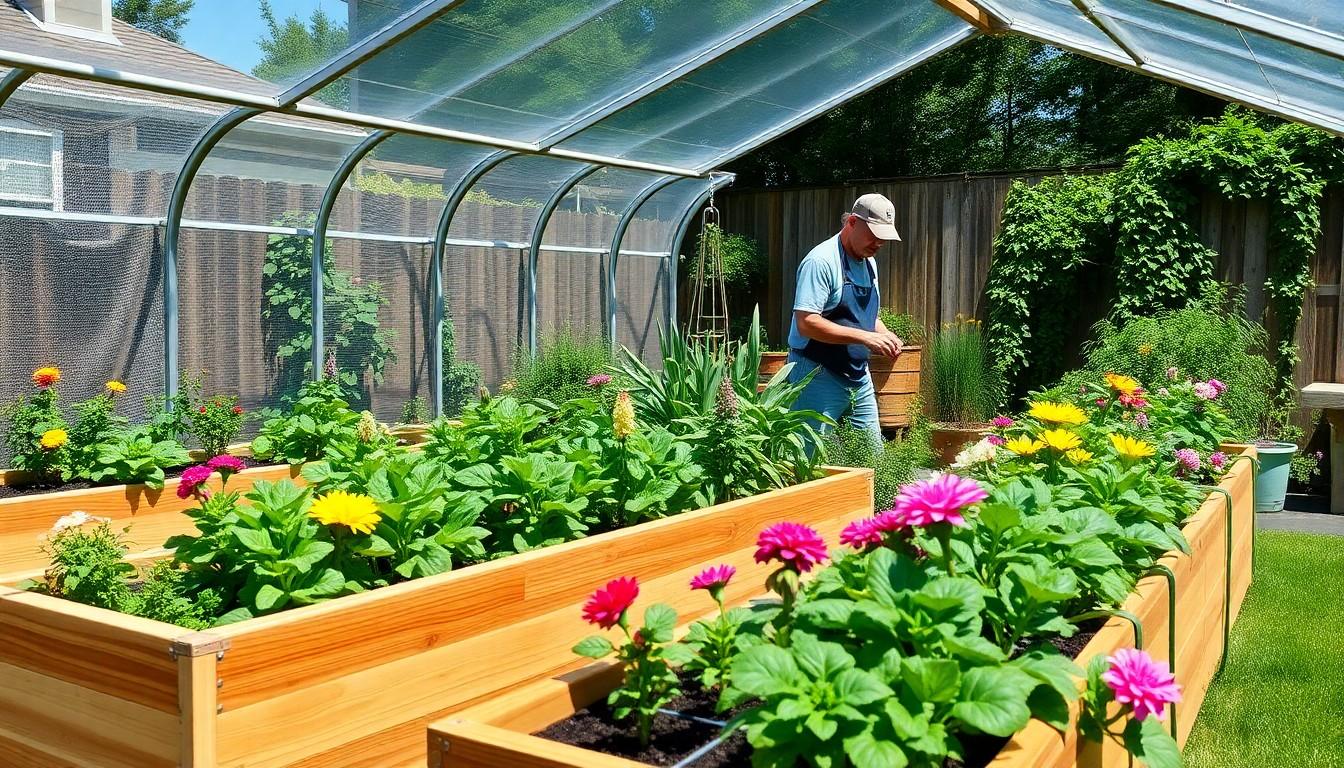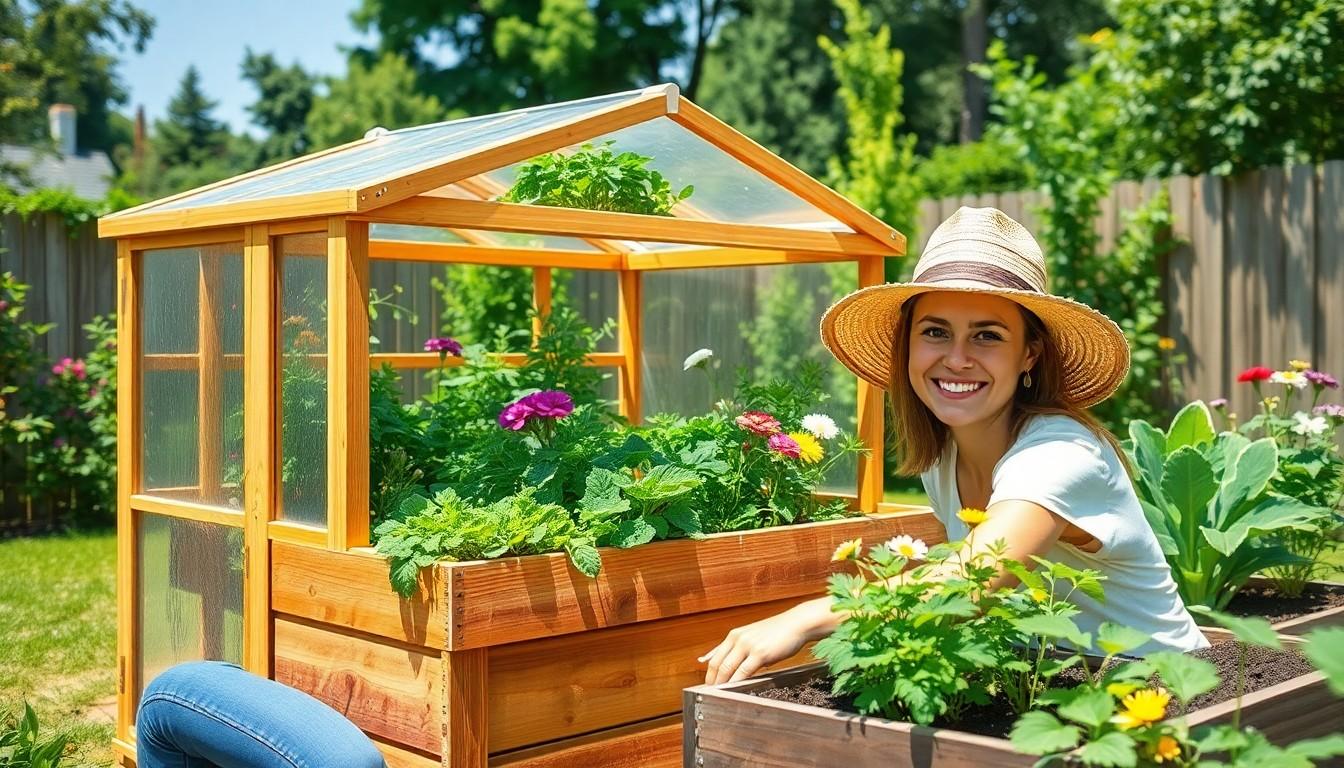Imagine stepping into your backyard oasis where fresh veggies and vibrant flowers thrive year-round, all thanks to a raised garden bed greenhouse. This magical combination not only elevates your gardening game but also keeps your plants safe from pesky critters and unpredictable weather. It’s like giving your plants a luxurious penthouse suite with a stunning view!
Raised Garden Bed Greenhouse
Raised garden bed greenhouses offer an effective way to enhance plant growth. They create a controlled environment, enabling gardeners to extend the growing season. This setup allows for better air circulation, warmth retention, and moisture management, which benefits various plant types.
Gardening enthusiasts appreciate the versatility of raised garden bed greenhouses. They can accommodate different plants simultaneously, including vegetables, herbs, and flowers. Raised beds also provide an accessible format, making gardening easier on the back and knees.
In addition to improving plant health, these greenhouses protect crops from harmful pests. Covered structures like these act as barriers, deterring insects and small animals while allowing sunlight in. This feature eliminates the need for harmful pesticides, promoting healthier produce.
Temperature regulation plays a crucial role in plant growth. Raised garden bed greenhouses can maintain optimal temperatures, minimizing fluctuations that harm growth. Experiences in these environments encourage stronger root systems, resulting in resilient plants.
The construction materials of raised garden bed greenhouses differ significantly. Common options include wood, metal, and recycled plastics. Each material provides unique advantages, impacting durability, aesthetics, and maintenance needs.
Overall, raised garden bed greenhouses represent a significant investment in sustainable gardening practices. By combining versatile designs with protective features, gardeners maximize their yields and enhance the enjoyment of cultivating plants.
Benefits of Using Raised Garden Bed Greenhouses

Raised garden bed greenhouses offer numerous advantages for gardening enthusiasts. These structures optimize plant growth and simplify maintenance through various environmental controls.
Improved Soil Quality
Soil quality receives a boost within raised garden bed greenhouses. Gardeners can mix the optimal soil blend, enhancing nutrient availability and drainage. Raised beds also prevent soil compaction, allowing plant roots to expand without restriction. Consistent soil temperature supports better microbial activity, which enriches the soil ecosystem. Organic materials improve soil structure, leading to healthier plants and increased yield potential.
Enhanced Drainage
Drainage becomes more effective in raised garden bed greenhouses. Elevated beds prevent water accumulation, reducing the risk of root rot and other moisture-related issues. Better drainage allows excess water to escape while retaining the necessary moisture for plant growth. This balance creates a suitable environment for various plant types. Additionally, gardeners can tailor the drainage system to fit specific crops’ needs, promoting robust growth.
Pest and Weed Control
Pest and weed management improves significantly with raised garden bed greenhouses. Elevated structures create physical barriers that deter pests from accessing crops. Less weeding occurs since raised beds often minimize the presence of weeds. This setup allows for easier identification and removal of leftover weeds. Using this method can reduce pesticide application, leading to healthier produce. Ultimately, this system fosters a more sustainable gardening practice, promoting biodiversity and healthier ecosystems.
Design Options for Raised Garden Bed Greenhouses
The design options for raised garden bed greenhouses play a crucial role in their functionality and aesthetics. Various choices exist to optimize plant health and garden efficiency.
Size and Layout Considerations
Size impacts the type of plants that thrive. Standard widths for raised garden beds vary from 4 to 6 feet, allowing easy access from both sides. Lengths can extend up to 12 feet or more, depending on available space and plant selection. Layout also matters; maximizing sunlight requires considering the greenhouse’s orientation. Arranging beds in a grid allows for efficient use of space, while staggered layouts enhance airflow. Prioritizing accessibility ensures easy maintenance and harvesting.
Materials and Construction Techniques
Material selection influences durability and aesthetics. Wood remains popular due to its natural beauty and availability, while treated options resist decay. Metal structures offer longevity and a contemporary look, appealing to modern gardeners. Recycled plastics provide eco-friendly alternatives, combining durability with ease of maintenance. Construction techniques also vary; simple designs often use screws and brackets, while more complex structures may involve framing and glazing. Ensuring waterproofing protects against moisture damage, promoting plant health.
Tips for Successful Gardening in Raised Garden Bed Greenhouses
Gardening in raised garden bed greenhouses offers unique opportunities for plant selection and effective maintenance.
Plant Selection and Companion Planting
Choosing the right plants determines garden success. Select plants suited for greenhouse conditions to maximize growth. Examples include tomatoes, peppers, and leafy greens. Companion planting enhances plant health and productivity. For instance, pairing basil with tomatoes can deter pests and improve flavor. Rotating crops yearly prevents nutrient depletion, ensuring soil vitality. Consider plant height and spread when arranging for optimal sunlight exposure and airflow. Incorporating flowering plants attracts beneficial insects, further promoting a healthy ecosystem.
Maintenance and Care
Regular maintenance keeps raised garden bed greenhouses thriving. Watering schedules should align with weather conditions and plant needs. Inspecting plants daily helps identify issues like pests or diseases early. Fertilizing with organic options supports nutrient availability. Mulching conserves moisture and suppresses weeds, contributing to healthier plants. Additionally, maintaining ventilation prevents overheating and fungal diseases. Routine cleaning of surfaces discourages pests and ensures a hygienic growing environment. Implementing crop rotation and soil testing sustains soil quality and enhances overall productivity.
Gardening Journey
Raised garden bed greenhouses offer a unique blend of practicality and beauty for any gardening enthusiast. By creating a controlled environment they enable healthier plant growth while minimizing the impact of pests and harsh weather. This innovative gardening solution not only extends the growing season but also enhances the overall gardening experience.
With various design options and materials available gardeners can customize their greenhouses to meet their specific needs. The benefits of improved soil quality and effective pest control make raised garden bed greenhouses a sustainable choice for cultivating a thriving garden. Embracing this method can lead to increased yields and a deeper enjoyment of the gardening journey.





